Introduction
Underlying the changes in the dynamics of the global economy due to various socioeconomic and environmental crises also impacted the labour market outcomes. Technological progress, ageing, and social protection are some of the most cited trends that are shaping the labour market, along with several efforts to mitigate climate change perils. Slower economic growth, food insecurity, inflation and political unrest also pose the greatest risk to jobs.
Many of these snags are seen as potentially disruptive. Thus, the concerns about disruptive technology are not new. Ever since the industrial revolution, the idea and fear that emerging technologies will create massive job losses have been in public debates. Back in the 1930s, John Maynard highlighted the concept of “a new disease …. namely, technological unemployment” (Keynes, 1931). As per the World Economic Forum report, a net of 14 million jobs will be vanished by 2027 due to automation.
Due to the low attainment of skills needed to survive in the job market, more people will be unemployed. Hence, the dependency ratio will be aggravated. Currently, it (% of the working-age population) is reported at 69.9% in Pakistan compared to India and Bangladesh, i.e., 48% and 47%, respectively. The reasons behind this are low employability opportunities for youth and the labour force and half of the women performing unpaid work in agriculture or engaging in caregiving activities at home. This trend will further worsen the labour market condition in future. Government should revisit the existing policies and coordinate with other departments to develop a composed framework to combat the factors that will affect the future labour force of Pakistan.
Nudging Factors
Poor Education Quality
The attainment of quality education improves labour productivity, which is seen as the major indicator of increasing an individual’s and enterprise’s economic outcome. In Pakistan, the literacy rate remains the same or increases slightly. The literacy rate is an important indicator that affects the quality of education, and it means the percentage of people who can read and write. Countries with high literacy rates will have high standards of living. The graph shows that the literacy rate hovers around 55 to 60% (WorldBank, 2021).
Due to a lack of quality education, 45% of students cannot read a sentence in Urdu and 44% in English. Of these, 54% are boys and 51% of girls. In contrast, the percentage is higher in Khyber Pakhtunkhwa, as 86% of the students have problems with reading and understanding math (ITA Report, 2022). The diminishing quality of education is due to poor teaching methods and environment and outdated syllabi.
 It shows that Pakistan is not investing in the education sector to uplift the quality of education. In 2021-22, the country spent only 1.77% of GDP. Many UN organisation has recommended that the government increase its educational section budget up to 4%.
It shows that Pakistan is not investing in the education sector to uplift the quality of education. In 2021-22, the country spent only 1.77% of GDP. Many UN organisation has recommended that the government increase its educational section budget up to 4%.
Moreover, the subjects taught in schools are irrelevant to the new technological trends. Pew and World Bank found that 49% of people work in jobs unrelated to their formal around the world (Mortiz & Zahidi, 2023).
Out-of-School Children
UNESCO estimated that 20 million children are out of school and hold the position of the world’s second-largest country. It represents 44% of the total population of the age group of 5-16-year-old children who did not attend school.
If we look at the pie chart, Punjab has the highest number of children who did not attend school, i.e., 7.7 million; in Sindh, it was 6.5 million. Among OOS children, 54% are girls, and 46% are boys. 87% of students reported never enrolling in schools because it is too expensive for them. 31% of students out of school are unwilling to attend, and 19% reported that schools are too expensive. 13% discontinued their study to help at work and home, and 11% reported that their parents did not allow them. Moreover, 6% stopped attending school because of the long distance.
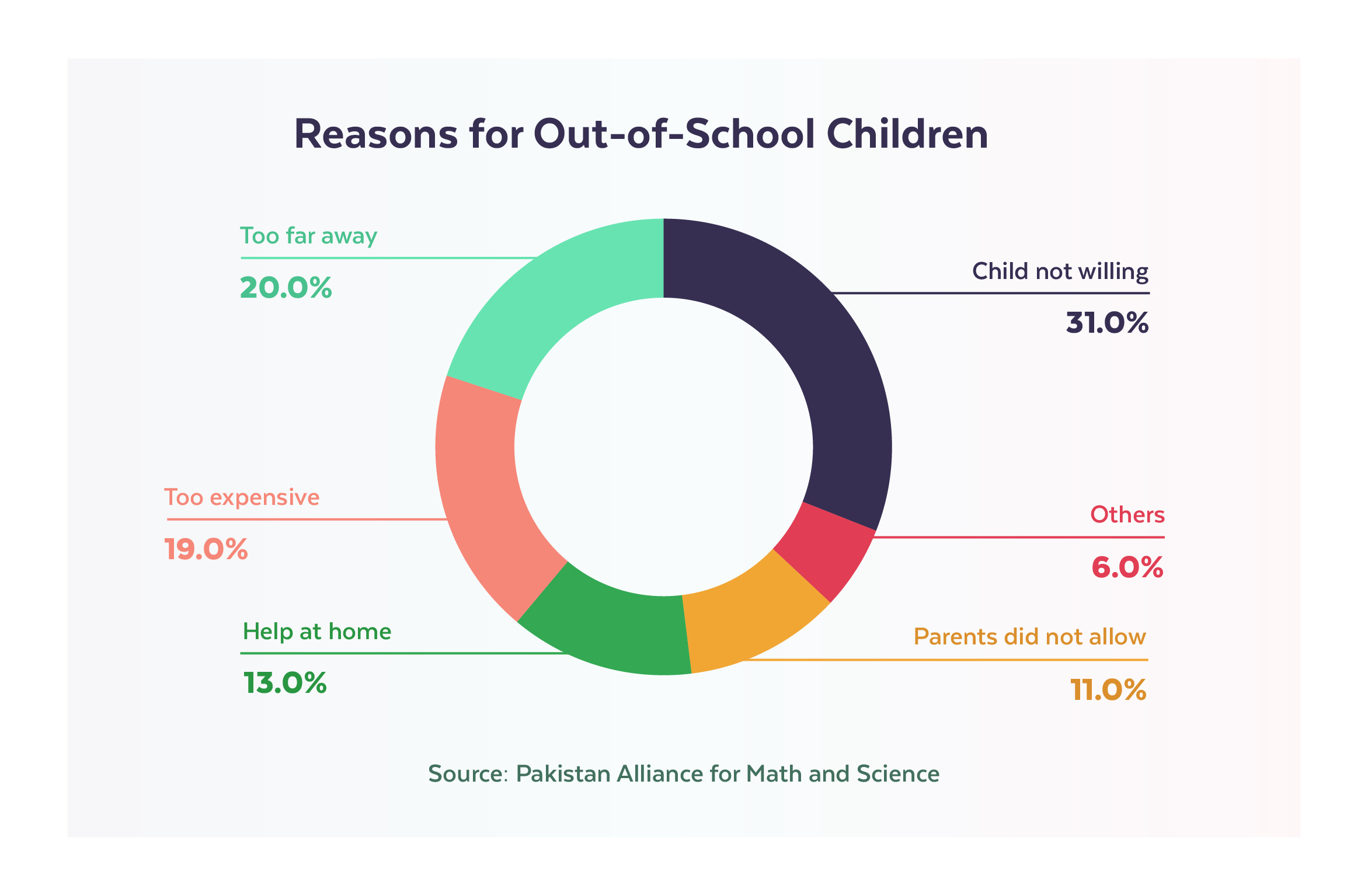 Out-of-school children and child labour are linked with each other. The Sustainable Development Goals (SDG) have mandated to achieve Universal Primary School education for all, but developing countries are unable to achieve it because of child labour. Poor families need children to work, which inhibits them from attending school (Putnick & Bornstein, 2015). In Pakistan, 3.3 million children are engaged in child labour due to a poor social security system, poverty, high illiteracy, unemployment and surging inflation.
Out-of-school children and child labour are linked with each other. The Sustainable Development Goals (SDG) have mandated to achieve Universal Primary School education for all, but developing countries are unable to achieve it because of child labour. Poor families need children to work, which inhibits them from attending school (Putnick & Bornstein, 2015). In Pakistan, 3.3 million children are engaged in child labour due to a poor social security system, poverty, high illiteracy, unemployment and surging inflation.
Stunting and Obesity
In Pakistan, under five years of age, four out of ten children are stunted, and seventeen are suffering from wasting. The double burden of malnutrition is becoming increasingly apparent, with almost one in three children underweight (28.9%) alongside a high prevalence of overweight (9.5%) in the same age group (UNICEF, 2018).
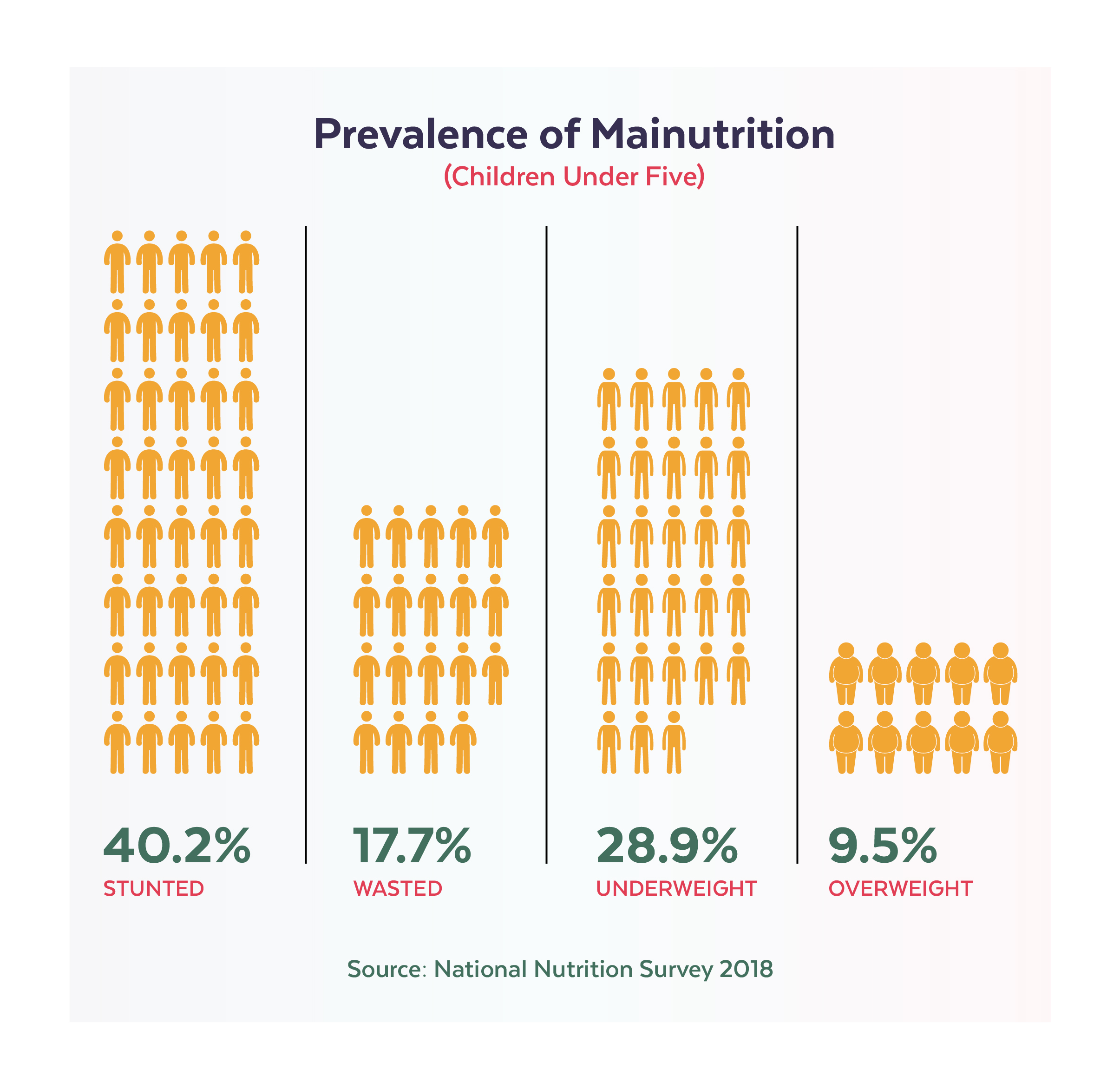 Stunting affects the development of the brain, which in turn reduces mental and physical capabilities. Although children recover from stunting, the damage to their health continues. In those children, the risk of becoming overweight or obese after the age of two or later in life. People who have suffered from stunting in their childhood would have faced challenges in learning. It will impact their performance when they enter the job market and lead to earning low wages compared to people without childhood stunting. However, their lifetime earnings will be 10% less than those of healthy people (Trotsenburg, 2016).
Stunting affects the development of the brain, which in turn reduces mental and physical capabilities. Although children recover from stunting, the damage to their health continues. In those children, the risk of becoming overweight or obese after the age of two or later in life. People who have suffered from stunting in their childhood would have faced challenges in learning. It will impact their performance when they enter the job market and lead to earning low wages compared to people without childhood stunting. However, their lifetime earnings will be 10% less than those of healthy people (Trotsenburg, 2016).
Climate Change
The climate induces events are negatively affecting the labour market. Extreme weather conditions can be heat waves, droughts, heavy precipitation and increased occurrence and intensity of cyclones or from the different gradual processes of climate change, for instance, rising temperature, sea level rise, and continuously changing factors. For the past 20 years, Pakistan has been ranked among the top ten most affected countries due to 173 climate change events. Until now, 10,000 people have died, posing $4 billion in economic losses (Siddiqui, 2022). Climate change is adversely affecting the labour market in different ways, such as (ILO, 2020):
- In urban areas, due to floods and workers displaced to other areas and moreover, damage to the business, transport, and industrial infrastructure and settlement
- In rural areas, due to a greater incidence of heavy precipitation and/or extreme heat resulting in damage to agricultural crops.
- Business and enterprise operations will be impacted due to damage occurring in private and public infrastructure.
- The temperature increase will affect the labourers’ working hours and labour productivity (Occupation Health and Safety).
- Forced long-term and short-term migration due to income reduction and job losses.
Green Jobs Gap
Climate change has changed the demand for these skills also. Now globally, the demand for green skills has increased by up to 40% since 2015. And only 13% of the labour force has the skills that the organisation wants. The vast majority of green skills, such as data scientists, fleet managers and health workers, are not directly linked with it. The green job demand has the potential to change the labour market dynamics like technology has transformed (World Economic Forum, 2023).
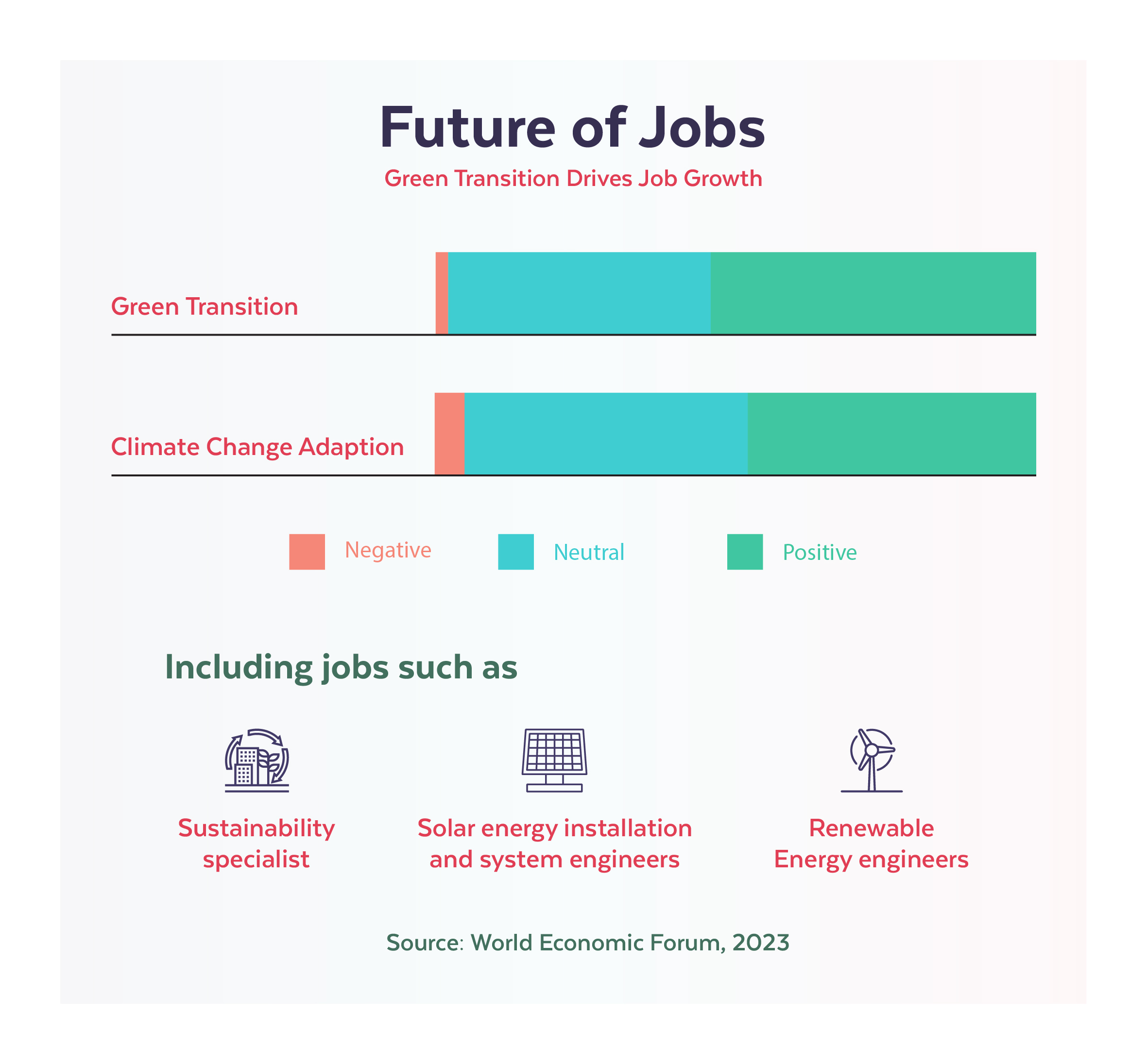 However, Pakistan is taking baby steps to promote green jobs. In 2021, the government made an agreement to create 100,000 green jobs in corporations with the world bank (Qadir, 2021). Increasing green jobs is a dire need of Pakistan in the wake of a continuous increase in climate induce events in the future.
However, Pakistan is taking baby steps to promote green jobs. In 2021, the government made an agreement to create 100,000 green jobs in corporations with the world bank (Qadir, 2021). Increasing green jobs is a dire need of Pakistan in the wake of a continuous increase in climate induce events in the future.
Long Term-Unemployment Leads to Ejecting from Labour Market
The country’s socio-economic condition has played a significant role in increasing unemployment. However, due to Pakistan’s crippling economic conditions in the last few months, 1 million people have lost their jobs, mostly working in the textile sector (Agarwal, 2023). In Pakistan, unemployment among young people is one of the highest in the world. An official government survey estimated that 37% of the youth are unemployed, and 67% of the young people want to leave Pakistan. The country is facing an acute economic crisis, and small businesses are closing their operation because they have to face high average variable costs. Hence, it is apprehended that the unemployment rate will increase and last for a few years, refers as long-term unemployment. As per the European Union Study, people who stay unemployed for more than one year have about twice as low a chance of finding employment than those who are unemployed for a short period. These people who are unemployed for longer periods are at risk of leaving the labour force (EU, 2015).
Insufficient and Inefficient Social Protection System
Pakistan is a young country; its population is growing exponentially, and its workforce is also increasing. Thus, more jobs are needed, and it will exert more pressure on existing resources.
The number of beneficiaries has increased to 78.6 million as compared to 40.8 million. Of these beneficiaries, 6.63% are receiving social insurance, 92.3% social assistance and only 1% were involved in labour market programs. Coverage rates for the main target groups, including underemployed, unemployed, poor, persons with disabilities, children and elderly, remained quite low but have increased as compared to 2015.
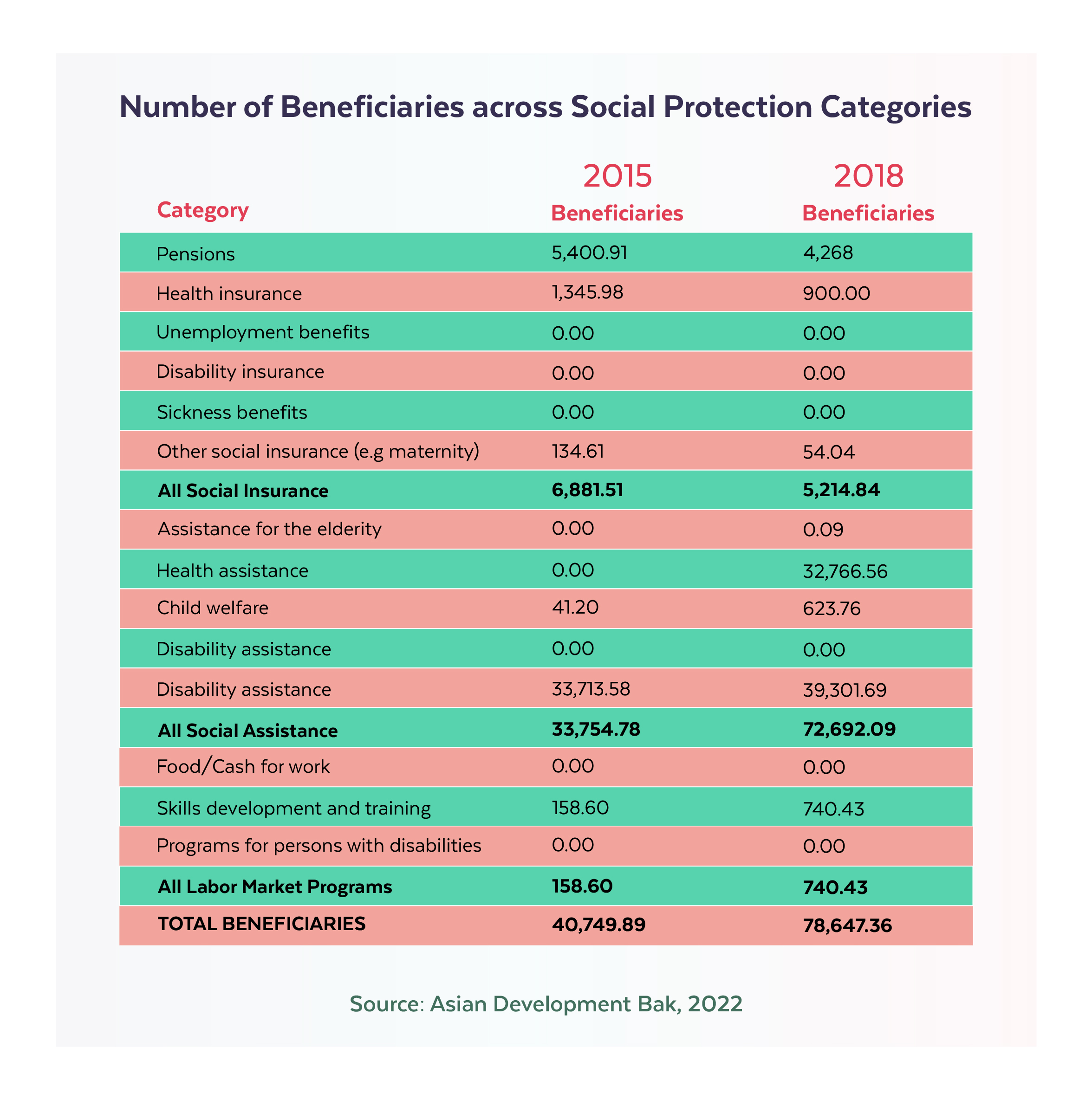 The social protection program covered 32.4% of the target population as compared to 19.2% in 2015. The highest coverage was for people with disabilities, i.e., 49.3%, mainly because of BISP funds. The elderly people (6.8%) are covered under the social insurance programs as they have worked in the military and civil services. The coverage of the unemployed and underemployed remains low, i.e., 4%, and it shows that the government is giving the least importance to the intervention for employment generation and developing skills (Asian Development Banks, 2022).
The social protection program covered 32.4% of the target population as compared to 19.2% in 2015. The highest coverage was for people with disabilities, i.e., 49.3%, mainly because of BISP funds. The elderly people (6.8%) are covered under the social insurance programs as they have worked in the military and civil services. The coverage of the unemployed and underemployed remains low, i.e., 4%, and it shows that the government is giving the least importance to the intervention for employment generation and developing skills (Asian Development Banks, 2022).
Social protection is not covering the informal sector. EOBI will cover this sector, and Employee Old Age Benefits Act (EOBI) has a strict clause that will only apply to that enterprises with at least 5 employees. Therefore, the unprotected sector comprises of 58 million workers, and only 7.12 million are protected workforce (Ahmad, 2020). Pakistan is one of the most populous countries, and the percentage of old people will increase to 8.5% and 12.9% in 2030 and 2050, respectively. The country is amongst the lowest pension coverage countries (2.3%), which will increase the dependency ratio and income insecurity for elderly people (Abdullah, 2021).
Low Female Labour Force Participation
In Pakistan, women are mostly working in homes and agriculture. Female labour force participation is half the male participation. Only around 20% of females are allowed to work outside their homes. Around 37% of women have reported that male family members didn’t allow them to work. Sixteen per cent reported that women do not want to work outside the homes, and 8% stated that they do not have enough opportunities. Thirty-six were reluctant to go out due to family responsibilities (Shahid et al., 2022).
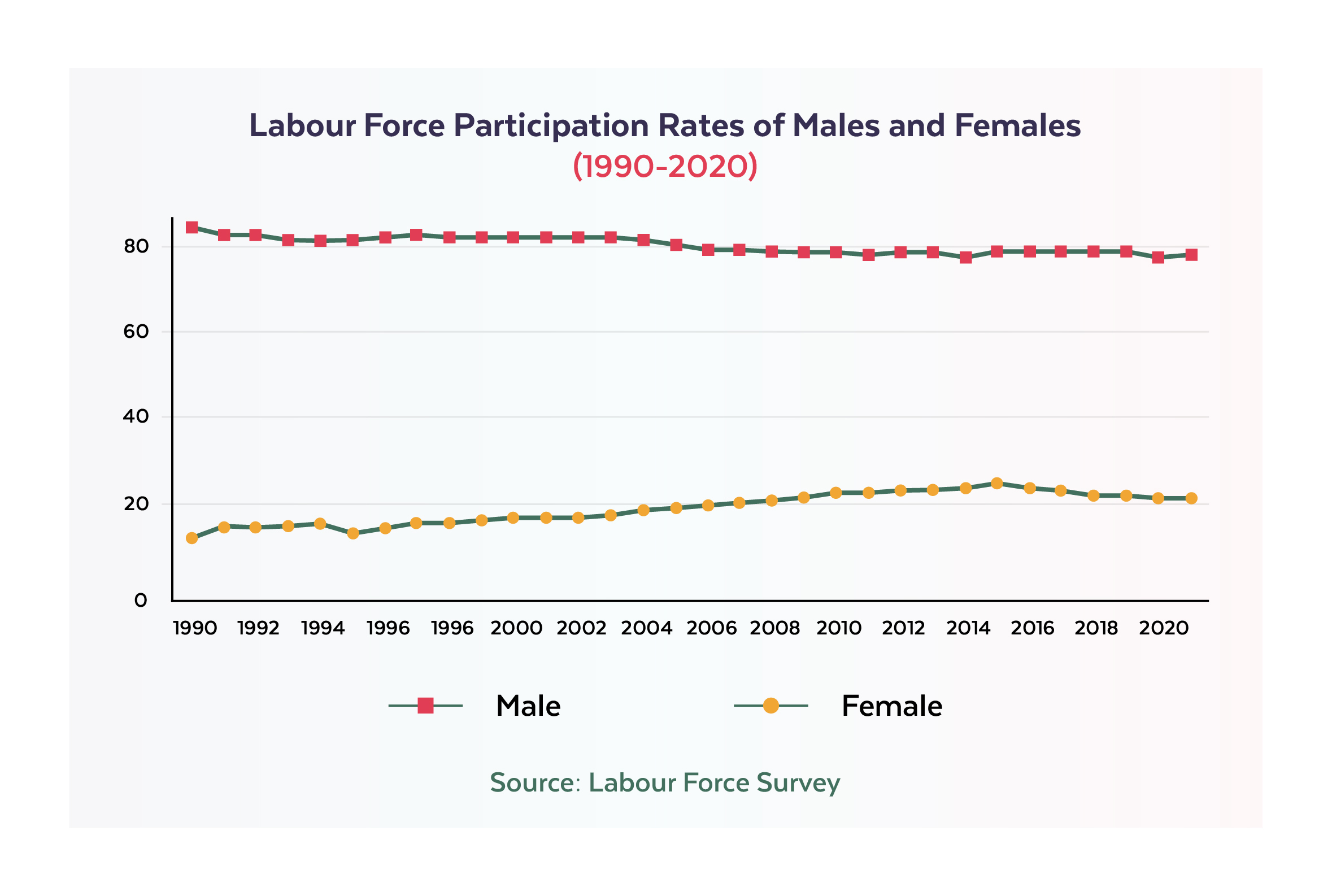 Due to low female labour force participation, the dependency rate will increase, reducing household incomes and driving households into poverty. Female labour participation is an important driver of economic growth and development.
Due to low female labour force participation, the dependency rate will increase, reducing household incomes and driving households into poverty. Female labour participation is an important driver of economic growth and development.
Technology and Automation
As per the Society of HRM and Wills Tower Watson’s study 2020, “85% of the jobs in 2030 have not yet been invented”. In the United States, approximately 1.5 million jobs will become obsolete due to robotics. In the future, 65% of companies will heavily depend on automation to perform data processing, information retrieval, HR and transmission and other jobs needed (Batada, 2022). Workers performing tasks requiring less proficiency, such as cashiers or file clerks, are at risk. Nine per cent to 47% of the jobs could be automated in the future (GAO, 2022).
As per World Economic Forum, major disruptions will occur in the next five years in the labour market as companies will acquire AI. It is forecasted that 83 million jobs will vanish due to AI and the socioeconomic condition of a country, with only 69 million jobs created by 2027. Overall, 14 million jobs will be vanished, which is 2% of current employment.
Only 40% of Pakistani youth will have the skills required by 2030. The country is unprepared to welcome the new era of innovation and technology. Because 40% of the population of Pakistan is illiterate, internet penetration is not much better at 25 per cent (Sayyed & Iftikhar, 2023). Pakistan has already missed the industrial revolution, and it’s a time to work hard to fill the gaps and keep steps ahead to reach the standards of developed countries.
Nonconductive Environment for Startups
Self-employment and startups are important for personal and country growth. In Pakistan, startups are struggling to sustain themselves. The main challenges these new venture faces are a shortage of product-market fit and other reasons: lack of finance, complex regulatory and operational issues, and lack of development potential and adaptability. In Pakistan, it is stated that 90% of start-ups fail every year; however, 80% of start-ups fail in India within five years. The reason behind the failure of start-ups is that entrepreneurs lack comprehensive vision, flawed VC funding, duplicate ideas without investing time in research, poor management and foresightedness etc. (Mir, 2022). The start-up ecosystems play a crucial role in generating employment, i.e., 15%, as Pakistan has low employment rates due to its fragile economy, pushing more people into the vicious cycle of unemployment (Yeh, 2023).
Flawed National Labour Policy
The National Labour policy aims to create a harmonious working relationship between employers and employees to increase the performance and efficiency of the industry. The Government of Pakistan has initiated two policies, i.e., Pakistan Labour Policy 2010 and Punjab Labour Policy 2018. These are important to showcase the implementation process and needs of the labour. Both policies have flaws, such as weak enforcement mechanisms, inadequate protection for vulnerable workers, insufficient social protection, and limited involvement of workers etc. The policies for the labourer can be improved with the involvement of the labour unions, but in Pakistan, it is observed that less than one per cent of the country’s labour force is unionised. Pakistan needs a strong labour policy to adopt the changing pattern of new technologies and work patterns. The composed and effective policy has the potential to protect the right of labour, promote decent work, attract investment and help to adapt and upgrade the worker’s skills to cope up with the technological change (Kunwar, 2022).
Ailing Industrial Sector
The firm-level data shows a gloomy picture of the industrial productivity of Pakistan over the past decades. It was estimated that there is a minute improvement in the least productive firms’ State Owned Enterprise (SEO). Additionally, there is no remarkable improvement in average productivity. The firm’s productivity was reduced by 23% in 2020 compared to 2019 because of COVID-19. In Pakistan, older firms are making less profit and becoming futile. The 40 years older firms are making a profit equivalent to less than a 10-year-old firm. Whereas in India, older firms make 30 to 40% more profit than younger ones (World Bank, 2022). In Pakistan, due to the economic crisis, the low productivity is caused due to increase in the cost of production.
However, the below-mentioned figure shows that the services sector dominates Pakistan’s economy and accounts for more than 50% of the GDP, and the growth in the agriculture sector is between 20 to 25%. Moreover, the manufacturing growth is lower than the services and agriculture sector, which ranges from 18 to 20 %. A prosperous industrial sector is needed to increase an economy’s national income and promote people’s living standards.
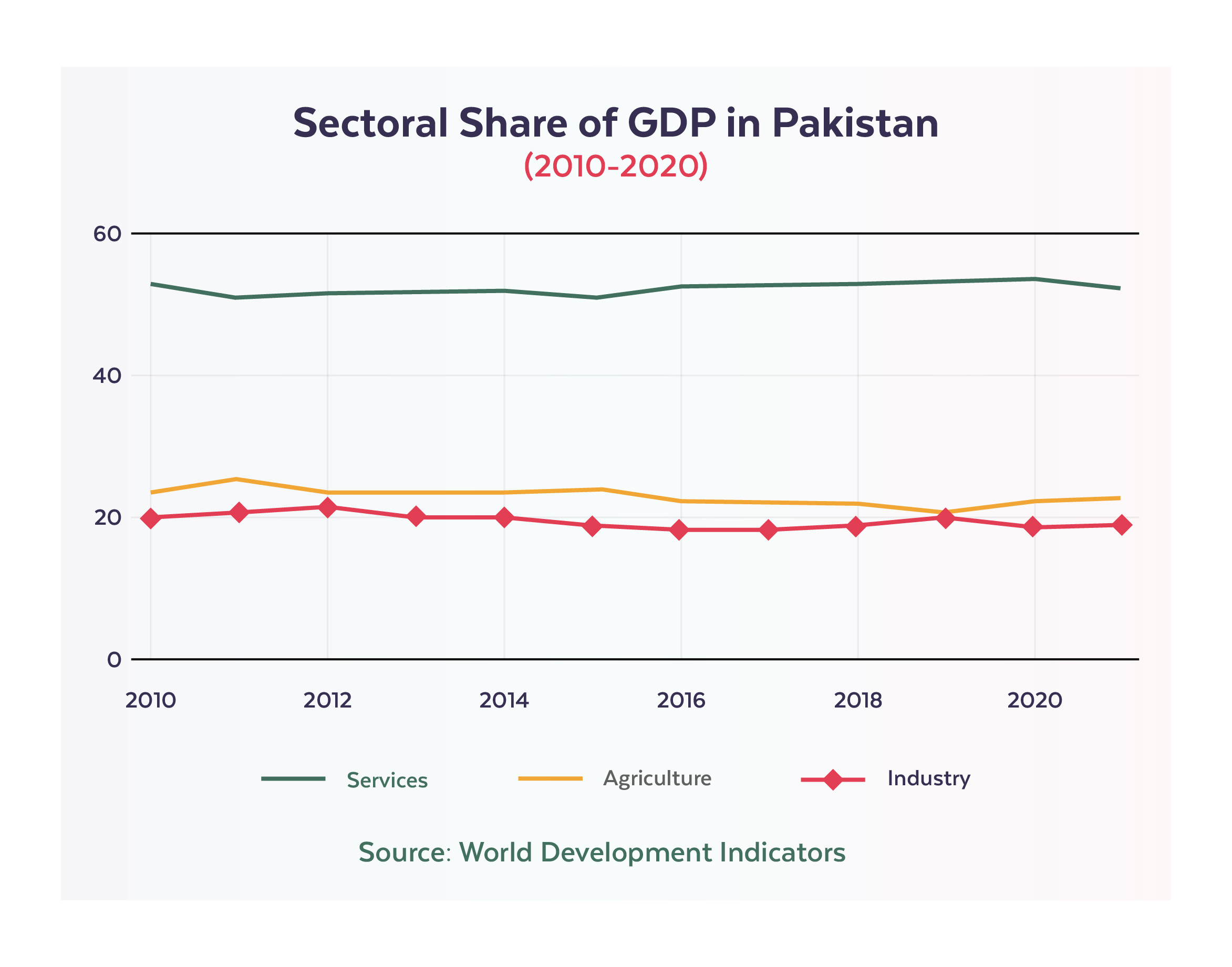 The low industrial productivity can be due to poor worker performance. Labour productivity defines as output per person; Pakistan’s labour productivity is estimated at $15,430 because of a lack of skills and strong work ethics among workers. The labour productivity of Pakistan workers is 20% less than the neighbour country. Labour productivity mainly depends on the diversification of industrial production and the incorporation of technology. The government is not heeding the importance of this sector, and it is anticipated that Pakistan’s future labour will not be prepared for future technological advancement, resulting in a low scale of production.
The low industrial productivity can be due to poor worker performance. Labour productivity defines as output per person; Pakistan’s labour productivity is estimated at $15,430 because of a lack of skills and strong work ethics among workers. The labour productivity of Pakistan workers is 20% less than the neighbour country. Labour productivity mainly depends on the diversification of industrial production and the incorporation of technology. The government is not heeding the importance of this sector, and it is anticipated that Pakistan’s future labour will not be prepared for future technological advancement, resulting in a low scale of production.
Recommendations
Increasing budget allocation on education and skill generation from 2.7% of GDP and then to 7% of GDP.
The curriculum should be revised on an annual basis, and new strategies and methods should be incorporated to align our educational system with other countries.
Sufficient funds should be set up for teachers’ training and development of a quality professional institute.
To mitigate child labour government should act on International Labour Organisation conventions and improve access to education, rigorous implementation of laws barring child labour coupled with social protection.
A short as well as medium strategy should be introduced help promote the concept of green jobs in construction, tourism and energy sector etc.
To reduce stunting, there is a need for strong policy advocacy to promote exclusive breastfeeding and laws protecting maternity and paternity leave, which help improve infant nutrition.
The government can devise policies to include the private sector in strategically safeguarding infants from stunting.
Expanding coverage and simplifying pension provision to cover all older people, including those living in rural areas, which are in greater proportion.
Improving employment and educational opportunities for elderly people.
Enhancing quality of healthcare facilities by adopting WHO guidelines on health and education.
Government should introduce a self-registration process with social insurance institutions so that these workers will get a pension in their old age.
To make the EOBI more sustainable, the government should increase the years of contribution from 5 to 25 years.
To make the social protection system efficient government should improve coverage, enhance transparency and accountability, finance, and incorporate data and digital systems.
To increase female participation in the labour force, there is a need to develop more women conducive policies, such as employers must provide maternity leave, paternity leave, nursing breaks and day care centres within the office premises. Moreover, the provision of safe and secure transport options for working women will encourage more women to work.
To improve productivity, the employer has to invest in training new employees and upgrading the skills of existing employees.
To adopt the technological advancement government has improved its IT infrastructure and increased funds to develop and implement it.
The government must comply with corporate governance rules and privatise the loss-making SEO to improve SEO performance.
Improve the innovation ecosystem by enforcing the protection of trademarks on export products.
Government should regularise private-public partnerships and investment in improving management services.
Strengthen and develop skilled human resources in order to increase productivity and efficiency.
The government should support the entrepreneur ecosystem by establishing incubators and technology parks.
Startups should conduct regressive research into their business because it will help them make informed decisions and navigate the complex startup process.
There is a need for more resources and facilities to conduct R&D activities, which can be critical for developing new products and services and staying ahead of the competition.
Government should revamp the legislative framework to improve the ease of doing business.
The government needs to revamp the National Labour Policy as per the need of the labour market and ensure its implementation process, whether tangible or intangible reforms.
Enhancing coordination between local administration and non-governmental and private bodies working for the reforming of the labour market.
This Policy Brief is written by Sehrish Irfan. Sehrish is a Research Analyst at the Iqbal Institute of Policy Studies (IIPS).
References
Abdullah, S. (2021). Ageing in Pakistan: A Curse or Blessing? Retrieved from PIDE: https://pide.org.pk/blog/ageing-in-pakistan-a-curse-or-blessing/
Agarwal, M. (2023). Pakistan economic crisis results in big layoffs; 1 million textile workers to be hit. Retrieved from Business Today: https://www.businesstoday.in/latest/world/story/pakistan-economic-crisis-industry-braces-for-job-production-cuts-over-1-mn-textile-workers-to-be-affected-371679-2023-02-28
Ahmad, I. (2020). Social Protection for the Unprotected Economy. Centre for Labour Research.
Asian Development Banks. (2022). Regional: Enhancing ADB’s Support for Social Protection to Achieve the Sustainable Development Goals. Retrieved from ADP: https://www.adb.org/sites/default/files/project-documents/52012/52012-001-tacr-en.pdf
Batada, S. (2022). Future of work. Retrieved from Tribune: https://tribune.com.pk/story/2388517/future-of-work (2015). Long-term unemployment: Commission proposal for a Council Recommendation. Retrieved from European Council Union: https://ec.europa.eu/commission/presscorner/detail/el/MEMO_15_5562
GAO. (2022). Which Workers Are the Most Affected by Automation and What Could Help Them Get New Jobs? Retrieved from US Government Accountability Office: https://www.gao.gov/blog/which-workers-are-most-affected-automation-and-what-could-help-them-get-new-jobs
ILO. (2020). Frequently Asked Questions on Climate Change and Jobs. Retrieved from International Labour Organisation: https://www.ilo.org/global/topics/green-jobs/WCMS_371589/lang–en/index.htm
ITA Report. (2022). 45 percent students can’t read a sentence in Urdu, ITA report. Retrieved from Daily Time: https://dailytimes.com.pk/905980/45-percent-students-cant-read-a-sentence-in-urdu-ita-report/
Keynes, J. (1931). Economic Possibilities for our Grandchildren. Retrieved from http://www.econ.yale.edu/smith/econ116a/keynes1.pdf
Kunwar, M. (2022). Labour Rights Continue to be Abused in Pakistan. Retrieved from Daily Times: https://dailytimes.com.pk/958414/labour-rights-continue-to-be-abused-in-pakistan/
Mir, Y. (2022). Why Startup fail in Pakistan? Retrieved from Daily Times: https://dailytimes.com.pk/963039/why-startup-fail-in-pakistan/
Mortiz, R., & Zahidi, S. (2023). Putting Skills First: A Framework for Action. World Economic Forum.
Putnick, D., & Bornstein, M. (2015). Is Child Labor a Barrier to School Enrollment in Low- and Middle-Income Countries? International Journal of Education Development, 112–120.
Qadir, A. (2021). Progress Made on Creating 100,000 Green Jobs in Pakistan. Retrieved from ARY News: https://arynews.tv/pakistan-green-jobs-youth-employment-tree-plantation/
Sayyed, M., & Iftikhar, N. (2023). What 2023 holds for the youth. Retrieved from The News on Sunday: https://www.thenews.com.pk/tns/detail/1025761-what-2023-holds-for-the-youth
Shahid et al. (2022). How Female-Friendly Are Workplaces in Urban Pakistan? Asian Development Bank.
Siddiqui, J. (2022). Pakistan’s Climate Challenges Pose a National Security Emergency. Retrieved from United States Institute of Peace: https://www.usip.org/publications/2022/07/pakistans-climate-challenges-pose-national-security-emergency
Trotsenburg, A. (2016). Malnutrition denies children opportunity and stunts economic development. Retrieved from World Bank: https://blogs.worldbank.org/eastasiapacific/malnutrition-denies-children-opportunity-and-stunts-economic-development
UNICEF. (2018). National Nutrition Survey. Ministry of Naational Health Services, Regulation and Coordination.
USIP. (n.d.). Pakistan’s Climate Challenges Pose a National Security Emergency. Retrieved from United States Institute of Peace.
World Bank. (2022). From Swimming in Sand to High and Sustainable Growth. World Bank Group.
World Economic Forum. (2023). The future of jobs is green: How climate change is changing labour markets. Retrieved from weforum: https://www.weforum.org/agenda/2023/04/future-of-jobs-is-green-2023-climate-change-labour-markets/
WorldBank. (2021). Literacy rate, adult total (% of people age 15 and above). Retrieved from World Development Indicator: https://databank.worldbank.org/source/world-development-indicators
Yeh, C. (2023). Why Are Startups Important for the Economy? Retrieved from richmondfed: https://www.richmondfed.org/publications/research/economic_brief/2023/eb_23-06#:~:text=However%2C%20their%20contribution%20to%20aggregate,the%20engine%20of%20economic%20growth.%22


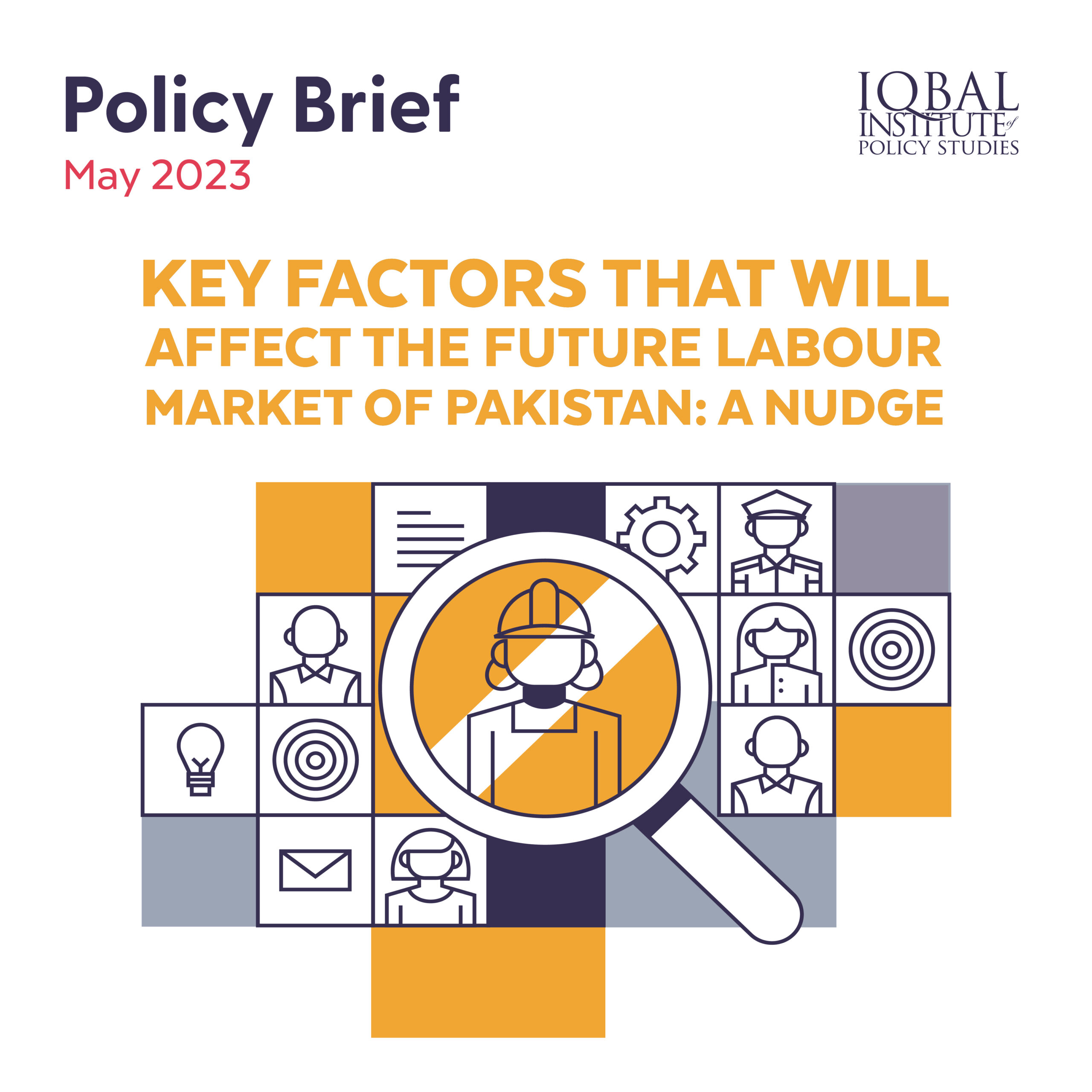
Leave a Reply